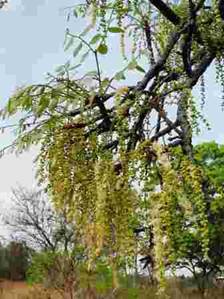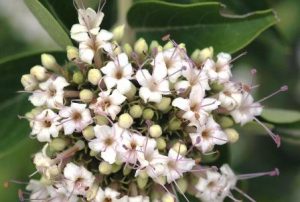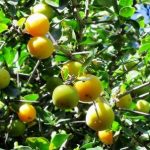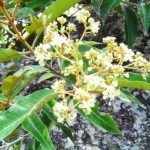TREE LIFE
May 1999
The annual subs ($80) are due. Please pay if you haven’t already done so, completing the invoice attached to April’s Tree Life, and indicate if your address has changed.
MASHONALAND CALENDAR
Saturday 1 May. Botanic Garden Walk Our walk in the economic section continues and we will also have a look at more of the little known and seldom seen species on Mark’s list. We will meet Tom in the car park at 10.45 for 11 a.m. There will be a guard for the cars.
Sunday 16 May. The AGM will once again be held under the trees at Christon Bank. After the meeting we will walk in the lovely woodland on the other side of the stream. Please bring your chair, tea with something to share and your lunch for later. We meet at 9.30 for tea prior to the meeting, which starts at 10 a.m.
Thursday 20 May. Dr Walters from Fairchild Botanical Gardens in Florida USA will be giving a talk at the Conquenar Hall (Reimbata) behind Haddon Motors along Samora Machel Ave East at 6.15 for 6.30 p.m. sharp. The subject will be Cycads and palms.
Saturday 22 May. Mark’s walk. Time 2.30 p.m.
Saturday 8 June. Botanic Garden Walk.
MATABELELAND CALENDAR
Sunday 22 May. Possibly to the Bambata Cave area. Meet at the car park in Girls’ College at 8 for departure at 8.30 a.m. To confirm the venue please phone Jonathan Timberlake , Tessa Ball at home or Gill Short at home.
The heavy rains this season and last seems to have had an effect on the seeding performance of some trees.
If anybody has access to Dovyalis seed or Khaya anthotheca, Ann Bianchi would be happy to buy some (c/o this box no.) Ann’s usual sources for this seed report that their trees have not set seed this season.
CHAIRMAN’S REPORT 1998 – 1999
This report is by necessity rather brief but I hope it gives a picture of the past year. Before you continue reading this report I wish to ask that both committees and the society as a whole really need a few more members. Please if you can spare an hour or two a month we would be delighted to see you or if you can rope in a few friends and bring them along on an outing.
The monthly outings that you enjoy are made possible by the dedication of the committees and also for the unstinting help we receive from our hosts. Without these virtually all the activities we enjoy could not take place.
The other aspect which forms an important part of the society are those who give so freely of their time and here I wish to thank Tom Muller for the Botanic Garden Walks, for queries answered and also general gardening information which you give so freely (its been a good one for Tom with rain interrupting 4 sessions!) and also to Bob Drummond for being on hand to identify sacks of plant matter that come back from trips. My thanks also to Mark Hyde for his invaluable contribution and also to Phil for standing in to lead walks. Most importantly the society runs so well thanks to Maureen’s dedication and I’m sure all members will join me in extending our thanks.
As everyone knows, Tree Life contains much information and as such is dependent on contributors’ articles. Lyn Mullin has provided us with an ever-increasing supply of fascinating material for Tree Life – Lyn thanks very much. I’m sure all members welcome the regular return of Nyarupinda Catchment, thanks Dickie for resuming your delightful column. John Wilson and Mary Toet have also been regular con¬tributors to Tree Life in their respective scientific capacities and our thanks to them.
Regarding the issue raised at the last AGM about the new fencing at the Botanic Garden. As the project is now fully operational the funds will be made available to the Gardens as soon as the investment matures. Thank you to all those who contributed in 1996/97.
Secondly, regarding the issue of an entry fee to the Gardens, the following has been suggested by the Gardens Committee.
A reduced price on a season ticket for individuals for entry to the Gardens.
The feeling of the Harare committee is for a reduced entry fee and/or none at all for members on our Botanic Garden Walks with Tom.
Please give this matter some consideration and let us know what you feel at the meeting.
Our Sunday outings seem to be popular with members of both branches, however, there is a nagging doubt that we are not really giving members what they want, or to encourage others to learn about indigenous trees. If you feel that something could be done, then, please forward your suggestions at the meeting.
The main outings over the last year included a weekend trip to the Nyoni Hills at the site of the Tokwe/Mukosi Dam to find Bivinia and update our mapping card before moving onto Buchwa Mountain, where after several attempts the elusive Bamboo was eventually found in a steep gully – it is gratifying that there are still plants surviving considering that the main colony disappeared in a mud slide some years ago. For Easter, the Honde Valley and the Tea Estates provided a weekend of great challenges in identification as the wooded areas around held unfamiliar tree species and plants in lush conditions.
Changes to the committee for Harare – we welcome John Wilson to the Committee, and thank Vida Siebert for so many years of service to the Society. Vida has resigned but says that she will continue to collate and post Tree Life so members shouldn’t have to worry. Special thanks to the Bulawayo committee for keep¬ing things going under difficult conditions. I hope the outings have been of interest and we thank Ms Nobanda at the Herbarium for permitting us to hold the AGM at Christon Bank.
-Andy MacNaughtan
Ann Bianchi has responded timeously with recipes for Kei Apple Jelly and Marula Jelly taken from an old book belonging to Margaret Speight and probably originating in the Bulawayo area.
KEI APPLE JELLY
Wash fruit and scald to remove skin.
Boil in as much water as will float the fruit.
When reduced to a pulp, strain off all the juice.
(Presumably through a cloth as for guava jelly for several hours?)
Mix 1½ lbs. sugar to each pound of juice (Metricate please)
Boil until jells when tested. Bottle hot.
And the book says ‘Good with mutton and venison’.
MARULA JELLY
Choose fruit that has just turned yellow, cut away black markings and slash skins all round. Just cover with water and boil till skins start to peel off (top up water to keep level just over fruit). Strain through double thickness muslin overnight.
Next day add sugar at ratio 1 lb. sugar to 1-pint juice; add juice of one lemon for each pint of Marula juice.
Boil rapidly till rosy colour and setting point is reached.
Also good with venison etc.
P.S.
Edone Petheram has made jam from Ficus sycomorus; Rob Burret has made jam from Parinari curatellifolia (contact Rob for a free sample); Benedicta Graves makes jelly from Carissa edulis.
Ruwa 21 March 1999
The previous day’s rain caused concern and hurried telephone calls as the river was flooding over the low level bridge lucidly the depth had receded to ankle height by the time John Lawrence negotiated the unknown. With the excitement it seems that few members – or were they just being polite – made mention of my typo in the directions where a distance of 2.5 km become 7 km for reasons unknown! Geoff suggested that we walk along a cleared path not far from the house as a wall of clouds was piling up to the east.

Burkea africana. Photo: Mark Hyde. Source: Flora of Zimbabwe
The Ruwa area is typically that of the high veld with open Brachystegia woodland interspersed with Mnondo, Combretum molle and Burkea africana. A few nice undamaged specimens of the violet tree – Securidaca longipedunculata occur near the numerous termitaria.
As with all termite mounds a greater density of species occurs and here are some very large (by Mashonaland standards) Clerodendrum glabrum, too high for leaves to be plucked and given to unsuspecting visitors to sniff the foetid odour. Other species noted included a Tarenna neurophylla, the pleasantly scented shrub Lippia javanica and the give away bright green leaves of Dovyalis zeyheri, complete with tracks left by the leaf miner. Suddenly a few spots of rain fell without warning followed by a downpour and whilst the lead group made it to the house the rest of us sheltered under various trees – ours was an immense Grewia monticola which provided little shelter once the wind started.

Clerodendrum glabrum. Photo: Bart Wursten. Source: Flora of Zimbabwe
Onto the main reason for our visit – plants with economic uses:
Jatropha curcas – generally a small spreading tree with deeply lobed leaves and in Zimbabwe it has become naturalised around sites of habitation including ancient ruins with large populations of the plant found in the Mutoko district. It is relatively quick growing and can be easily propagated from truncheons and as it tolerates marginal areas it has considerable potential for a cash crop in communal areas. The trees respond to pruning with the fruits being produced at the terminal branches. A fleshy capsule, which has no oil value, is discarded while the black coloured seeds are of interest as they contain 40% oil. After processing the cake, the waste fibre of the seeds can be used as a fertilizer but as toxic Phorbyl esters are present a process developed by a German company has to be used to detoxify the product. Some of uses of the biodegradable oil vary from a soap made by Geoff and Joyce to which a variety of essences are added to suit both feminine and ultra masculine taste, to a an industrial use as a machine tool coolant. Another feature of the oil is the strong anti fungal properties.
The other species of commercial interest is the Moringa, Moringa oleifera, which is an attractive medium sized tree with pale green compound leaves containing large numbers of small rounded leaflets and a pale bark. The leaves, roots and long flattened pods are edible; however, a browse additive may be required if fed to livestock in any quantity. Being a legume the plant doesn’t suffer from the ‘nasties’ that are to be found in the Euphorbiaceae. The tree is reasonably frost resistant and does not yet seem to be as invasive as other naturalised exotics.
The other indigenous species with significant oil content in the seeds is another of the Euphorbiaceae – Croton megalobotrys. As noted in Coates Palgrave the seeds have been used for treating bouts of malaria. Perhaps Douglas Ball could shed some light on this treatment?
A most interesting and informative day as well as a wet one. Thank you Geoff and Joyce for your hospitality and for the supply of spare clothes for those of us who stayed out in the rain.
If anyone is interested in the Plant Oil Producers Association please contact Geoff or Joyce at P.O Box GD 993, Greendale, Harare.
-Andy MacNaughtan
Jatropha curcas (L)
A potential Crop Plant for Zimbabwe.
A visit to Geoff and Joyce Oliver’s Farm in the Ruwa area renewed interest in the potential of Jatropha curcas as a potential crop for Zimbabwe.
The Plant Oil Producers’ Association (POPA) is an autonomous, non-profit making body encouraging the production of plant oils throughout Zimbabwe. Work has been done to try to involve Government and Non Governmental Organisations in the development of the crop in communal areas.
ART Farm has had a trial site since 1991 to establish plant spacing and seed yields. Work is being done to find the most suitable method to detoxify the crop. The expressed seeds could then be used as a cattle feed. A number of investigations have been undertaken for the uses of the plant oil. These are very varied and include:
? Processing into hydraulic oils, lube oils and greases.
? A diesel fuel substitute or extender
? Production of soap and candles
? The pressed cake for organic fertilizer or livestock feed once detoxified
? As insecticide for use in Agriculture.
The seeds are high in oil (35-45%). The oil is extracted by pressing and this can be done on a hand operated piston press, or by solvent extraction. The solvent extraction is expensive and uneconomical.
25% oil in solvent can run tractors but one hectare would produce 500 litres and the average tractor use is 1500 litres a year. The imported solvent probably hexane would be more costly than the subsidized price of diesel. An 80% Jatropha oil 20% petrol ethanol has been used to run some diesel engines. Not all engines are suited to these mixes and in the long term damage could result.
For the past two years the world price for petrol has been decreasing so as an export commodity it would not be attractive.
On a small rural farm paraffin can be obtained cheaply and is the main source of lighting and cooking fuel. Fuel for lighting and cooking obtained from Jatropha oil would not be an attractive alternative.
In Nicaragua research students are extracting the methyl ester from Jatropha curcas to add to diesel but this is proving to be expensive.
If it were to emit a less carbon-laden exhaust than normal diesel it could become very attractive in countries suffering pollution from exhaust emissions. Unfortunately these are the poorer nations who are unable to import but could benefit if they were to become producers.
A more feasible option is to use the oil as a lubricant because this fetches a higher price. With the correct additives it can be used as a cutting oil, chainsaw oil and hydraulic oil.
The shells can be used for biogas production. A commercial farmer would benefit from biogas if crops such as tobacco and paprika needed curing and drying. It would take longer for a rural small scale farming community to accept such an innovation. At present there is an interest in Solar Powered Dryers that have worked for kapenta, vegetables and paprika. These are cleaner and easier to use than methane.
The residue from extraction has insecticidal properties. Formulation into a commercial insecticide would require an additional pesticide, as most of the natural insecticides are not as effective as the chemically synthesized.
A very attractive soap was prepared and one was delightfully scented with lemon grass extract. This, though unintended proved very popular with the Tree Society members. Although it may remove red stains on the skin any claim would have to be substantiated by the Medicines Control Council. The glycerol and extracts from Jatropha curcas may well find a place in the expanding cosmetic industry throughout the World.
Jatropha oil is recorded as a purgative, arrow poison and fish poison. It is poisonous and should not be eaten.
The plant or tree has been grown for sometime in the rural areas and when a call was made for seed at Z$1 per kg, over 80 tons was produced. This gave seed for the start of the industry.
The tree is attractive because it grows in marginal areas not suitable for cropping provided there is adequate drainage. It requires as little as 200mm rain but more water produces bigger yields.
Recorded yields range from between 2000kg seed/ha rain fed to 10000 kg seed/ha with supplementary irrigation. The trees reach maturity in 2-5 years and have a life span of 50 years. The anticipated yields are good.
The tree is easy to grow and is not damaged by mild frost but is burnt by severe frost at higher altitudes. The tree grows well in low areas such as the lowveld and Kariba. The writer has seen cattle pens made from a hedge of Jatropha trees in the Zhombwe area between Murewa and Mutoko.
The tree can be used for soil stabilisation when the trees are planted across gullies and unwanted watercourses. The amount of erosion in the Zhombwe area is bad this year with double the normal rainfall record¬ed for Murewa at over 1300mm to date. It can be used to revegetate denuded areas that are bad where soils are poor and there has been over-stocking.
Harvesting is simple and the seeds fall when the tree is shaken. Only the mature pods fall and the picking period could be prolonged which would affect the economics.
A pamphlet from the POPA gives the price of Z$2000 per hectare for seed, which could be triple at today’s prices. However this is not an attractive proposition when compared with lucrative cash crops such as tobacco and paprika. Small-scale farmers on the ADF (USA) Paprika Project should realize ten to twenty times the amount of money on their paprika crops. These farmers are looking to lucrative cash crops and the scenario of subsistence farming is changing. Today market forces determine the survival of crops. A crop has to have an end use as some product for which there is a demand, and be correctly positioned in the market place to command the right price. Marketing is a complex science and many products fail because this is not recognized. The POPA are to be commended for looking at oil seeds and their diverse applications. Product development takes an amount of research and patience. Ultimately the success depends upon the market.
Speciality chemicals succeed best in niche markets. Nut husks, seed oils give ingredients from renewable vegetable resources and are replacing animal and synthetic materials. The naturally occurring tocopherols in seeds embryos have antioxidant properties and are widely used in the cosmetic industry. Mango kernel oil produces ethoxylated vegetable glycerides that make clear surfactant systems providing moisturising benefits in creams, lotions, shampoos, bath and shaving products. Another example is the castor oil been where the oil is converted into emulsifiers and surfactants is a big industry.
Next time a Field Card is consulted Jatropha curcas is listed under the exotics. Other than looking at the Euphorbia characteristics and the quaint large lopsided leaves a thought should be given to its commercial potential, not to mention its ecological significance for poor sandy eroded areas.
Another interesting tree was the Indian Maringa with its long pods. The pods are edible and can be used as a stock feed. It is envisaged these small trees can be grown rather like lucerne.
To say the least the economic aspects were just part of a very enjoyable outing.
-MARY TOET.
Although exotics there are some superb trees outside Mount Pleasant Post Office.
Ann Bianchi has grown some but wonders if anyone knows what they are – a subspecies of Schizolobium (Reach for the Sky) – very similar seed, but much stockier trees than the usually grown Schizolobium. Does anyone know?
AMAZONIAN ANTI-VANDALISM
Hundreds of species of tropical plants provide food and shelter for ants, which, in return, rid the plants of unwanted leaf-munching insects. But American scientists have recently found an example in which the ants do their host more harms than good, shedding interesting light on the evolution of mutualism between some species.
Cordia nodosa, a common plant of the Peruvian Amazon, has hollow swellings on its branches. These ‘domatia’ house mostly Allomerus and Azteca ants, which vigorously patrol the plant and remove herbivorous insects. But Douglas Yu and Naomi Pierce of Harvard University, USA, found that Allomerus ants, which inhabit nearly 80% of plants, castrate their hosts by destroying the plant’s flowers. The vandalism benefits Allomerus because castrated plants put more energy into producing more leaves and shoots, resulting in more domatia and a more productive ant colony. But the plant loses out – 70% of plants inhabit¬ed by Allomerus produce no fruit.
What is surprising is that the plant still provides the cheats with a home. The scientists suggest that Allomerus are parasitising the healthier relationship that the plant has with Azteca ants, which don’t harm their hosts.
(BBC Wildlife – April 1999)
ANDY MACNAUGHTAN CHAIRMAN



